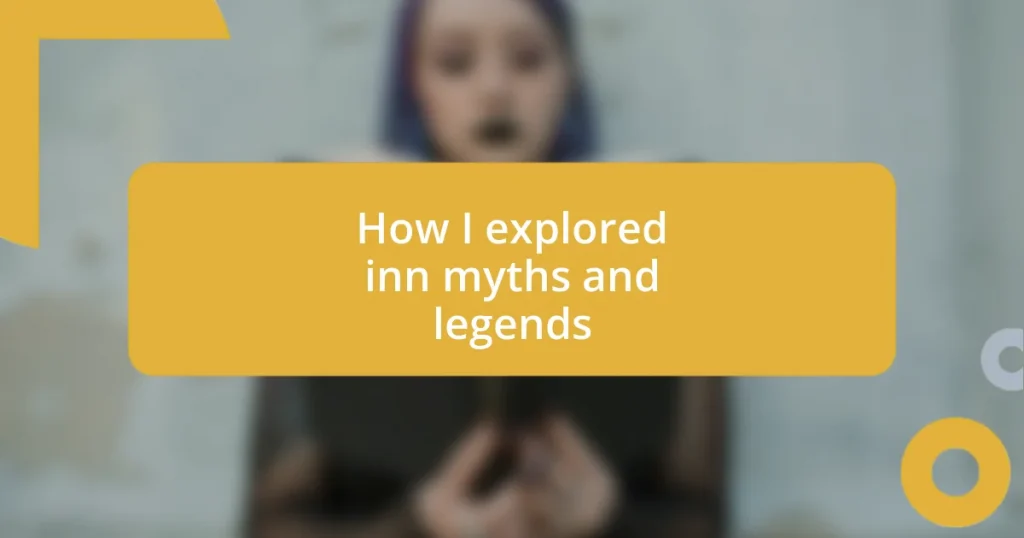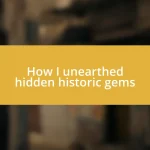Key takeaways:
- Inn myths reflect cultural fears, hopes, and the community’s shared history, enhancing connection and belonging among guests.
- Engaging with locals and documenting personal experiences enriches the understanding and appreciation of inn legends.
- Storytelling fosters community bonds, allowing shared experiences to create a deeper connection to the history of the inns and their surroundings.

Understanding inn myths and legends
Inn myths and legends often serve as windows into the cultural and historical contexts in which they were born. I remember the first time I heard about the ghostly innkeeper who supposedly roamed an ancient tavern, forever tied to the place he loved. This legend not only hinted at his ardent passion for hospitality but also sparked my imagination about the story behind his tragic fate. Why do these stories linger in our collective memory?
When exploring these tales, I found that many inn myths reflect the fears and hopes of communities. For instance, the legend of a benevolent spirit guiding lost travelers to safety can comfort weary souls seeking refuge. It makes me wonder—are we always looking for reassurance, even in places we think we know well?
As I dug deeper, I realized that these legends are not just quirky stories; they are rich narratives that evoke emotions and ask us to ponder our own experiences. They often reveal the timeless human struggle for connection, safety, and belonging. I once stayed at an inn that had its own local lore about a hidden treasure. The excitement it generated among guests showed just how powerful these myths can be in building a sense of community and shared history.

Historical origins of inn stories
Many inn stories can be traced back to a time when hospitality was crucial to survival on long journeys. In those days, inns served as more than just resting places; they were essential hubs for travelers who risked their lives on the unpredictable roads. In my own travels, I’ve often found that the tales shared by innkeepers not only gave me a sense of the place but also connected me to the heart of the community surrounding that inn.
- Inns were safe havens where wandering souls found food and shelter.
- Local folklore would often circulate, blending real events with supernatural elements.
- The oral tradition played a significant role in keeping these stories alive, as travelers shared them across regions.
- Each inn seemed to carry its unique stories of past patrons, imbuing the space with memories and emotions.
- I recall one night, sitting by a crackling fireplace in a rustic inn, listening to an elderly innkeeper recount tales of mysterious guests from decades ago, leaving me enchanted by the idea that each night held its own history.
The blending of history and myth in these stories speaks to our innate desire to connect with the past. I think of a quaint inn where I once spent a stormy evening, feeling the weight of the stories in the air with each gust of wind outside. The ambiance was thick with tales of shipwrecked sailors and hidden treasures, reminding me how deeply intertwined our lives become with the narratives of places we visit.

Notable inns with local legends
There are several noteworthy inns scattered across the landscape, each with its own unique legends that tantalize the imagination. One such place is The Whaley House Inn in San Diego, reputed to be one of the most haunted houses in America. During my visit, I felt a chill as I strolled through its historic halls. The stories of ghostly encounters with past residents became the backdrop of my stay, making me question whether I’d ever truly be alone as I drifted off to sleep.
Another gem is The St. James Hotel in Cimarron, New Mexico. It’s fascinating how the history of notorious outlaws and gunfights permeates the atmosphere here. On a quiet evening, I found myself pondering the fate of those old gunslingers while seated in the bar, where, according to legend, the sound of gunfire could occasionally be heard echoing through the walls. Was it merely my imagination, or was the past still lurking in the shadows?
Lastly, I must mention The Old Talbott Tavern in Bardstown, Kentucky. This place has been around since the late 1700s and is steeped in tales of Revolutionary War soldiers and ghostly visitors. When I dined there, I couldn’t shake the feeling that the walls, adorned with photos, were whispering old secrets. Their rich history added a palpable energy to my meal that I still remember fondly.
| Inn Name | Local Legend |
|---|---|
| The Whaley House Inn | Haunted by the spirits of former residents |
| The St. James Hotel | Echoes of gunfights from the days of outlaws |
| The Old Talbott Tavern | Visited by Revolutionary War soldiers and ghosts |

Techniques for researching inn myths
When diving into the world of inn myths, one powerful technique I find invaluable is tapping into local archives and historical societies. These treasures often house documents and records that illuminate the past, connecting me to the stories etched into the very walls of those inns. On a recent visit to a small-town library, I stumbled upon an old ledger that detailed the arrivals and departures of travelers, sparking my imagination—who were these people, and what tales did they carry with them?
Another technique I hold dear is engaging with the innkeepers themselves. Their narratives often intertwine with the legends, brimming with firsthand experiences that bring each story to life. I remember chatting with an innkeeper over breakfast, who shared a particularly haunting account of a guest who vanished overnight, leaving behind only the echo of their laughter. Such tales invite a sense of mystery and make the space feel alive with history.
Lastly, I often immerse myself in the local culture, as folklore is woven into the very fabric of the community. Attending town festivals or storytelling nights has allowed me to hear firsthand accounts from locals. On one memorable occasion, while gathered around a bonfire, I listened to an elder recount the tale of hidden treasure buried near an inn, which captivated everyone’s imagination. It made me wonder—what unspoken legends lie just beneath the surface, waiting for someone to uncover them?

Engaging with locals for stories
Engaging with locals is often where the heart of a story lies. I vividly recall a rainy afternoon at a cozy café near an inn. The elderly gentleman sitting next to me overheard my conversation with the waitress about local legends. He leaned in, eyes sparkling with enthusiasm, and shared a spine-tingling story about a woman in white who roams the nearby fields at dusk. His words painted vivid imagery that deeply connected me to the atmosphere surrounding the inn.
On another occasion, I joined a local ghost tour, eager to hear the lore straight from the town’s storytellers. As we walked the cobblestone streets, I found myself captivated by the passionate tales they wove. One tale about a long-lost love turned tragic filled the air with a sense of longing. The way the tour guide expressed the emotions made me feel as if I was peering into the town’s soul. Isn’t it fascinating how these narratives echo the dreams and heartaches of those who came before us?
I also took joy in simply striking up conversations with other guests. One night, I chatted with a young couple who had experienced unexplained occurrences during their stay at an inn. Their excitement was contagious as they recounted the mysterious tapping sounds that woke them in the middle of the night. These shared experiences not only brought us closer but also added layers to the legends I was uncovering, blurring the lines between myth and reality. Isn’t that the magic of local stories? They transform strangers into friends, all while stitching together a richer tapestry of the past.

Documenting personal experiences in inns
When I think about documenting my experiences in inns, I’m reminded of a delightful night spent at an old coaching inn nestled in a remote corner of the countryside. While enjoying a cup of hot cocoa by the fireplace, I chatted with a fellow traveler. She recounted her unsettling encounter with a ghostly figure that appeared in her room during the night. It was fascinating to see how these shared moments of fear and intrigue bonded us over stories that were both thrilling and personal, wouldn’t you agree?
On a different visit to an inn, I took to writing in a journal, capturing every little detail of the place—the creaky floorboards, the smell of aged wood, and even the old portraits that seemed to watch us. I remember pausing to reflect on how these elements intertwined with tales of past guests. As I penned my thoughts, I felt a connection forming with those who had stayed there before me. In that moment, I realized that by documenting these experiences, I was becoming a part of the inn’s ongoing story. Isn’t it powerful to think that our narratives can layer upon one another over time?
There was another time when I asked the innkeeper if he had any ghost stories to share, expecting mere anecdotal tales. What I received instead was an emotional recount of a traveler who lost their way but found solace in the inn. The innkeeper’s voice quavered as he described the warmth of hospitality that transcended fear. This level of sincerity struck me deeply and reminded me that behind every legend, there’s a pulse of real human experience. Isn’t that what makes our exploration of myths so compelling—discovering the humanity woven into the fabric of history?

Sharing findings through storytelling
Sharing findings through storytelling showcases the incredible power of narrative in connecting us to our experiences and the places we visit. I remember sitting around a fire pit one evening at an inn, where a fellow traveler began to spin the tale of a legendary creature that supposedly guarded the nearby woods. As I listened, the flickering flames danced in rhythm with his words, creating an intimate atmosphere that pulled us all into a shared reverie. How often do we find ourselves enveloped in stories that ignite our imaginations, blurring the line between reality and myth?
On another occasion, during a quiet morning at the inn’s breakfast table, I struck up a conversation with an elderly couple who had been visiting for decades. Their laughter resonated with warmth, especially when they recalled encounters with the inn’s purported ghost. They spoke of how sharing these stories over the years helped build cherished friendships with other guests. Isn’t it intriguing to think how stories passed down through generations can foster a sense of community and belonging, even among strangers?
I’ve also found that storytelling often happens spontaneously in the unlikeliest moments. One rainy afternoon, while sheltering in the inn’s library, I overheard a group discussing a series of bizarre happenings in the village. Their tales of unexplained noises and disturbed nights sparked a lively debate, and I couldn’t resist joining in. The more they shared, the more I felt the pull of the collective narrative. Isn’t it remarkable how, even in casual conversations, we can weave together diverse threads of experience into a cohesive tapestry of understanding?















